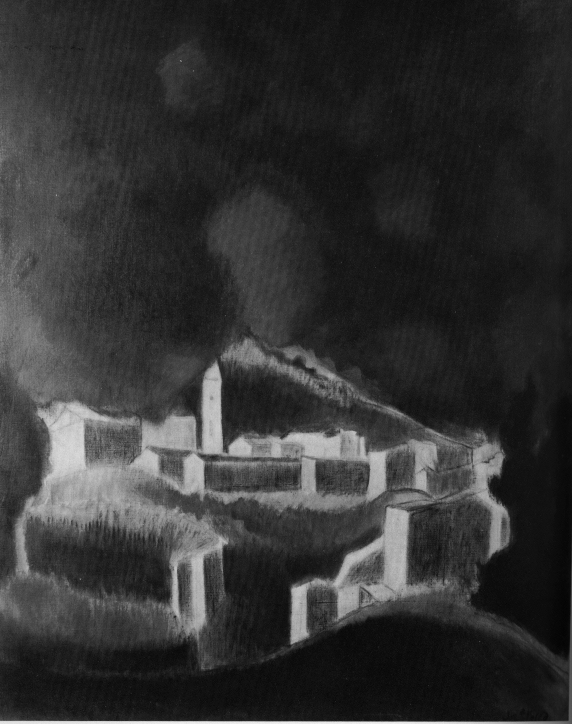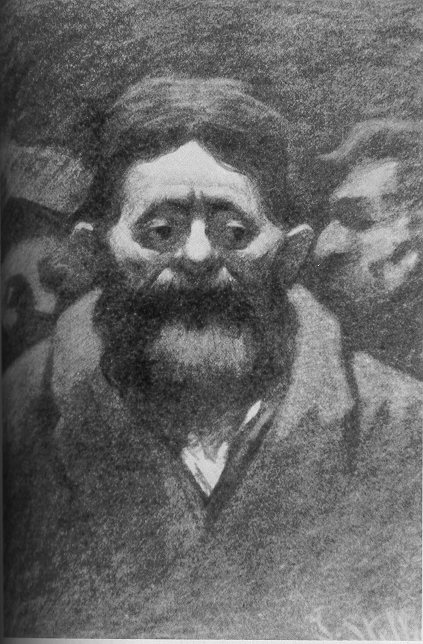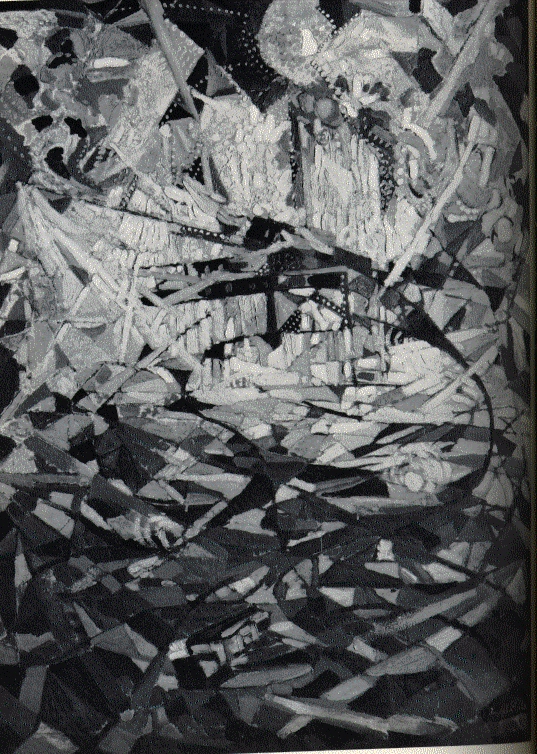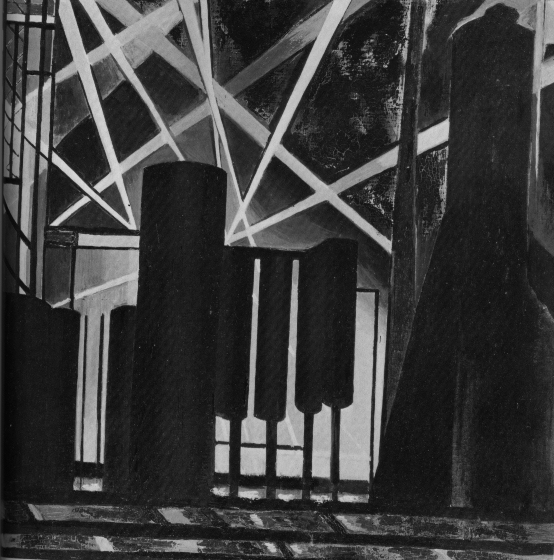| Joseph Stella is considered today as a great American artist; "with
his unique cultural and personal characteristics he not only enriched the
American heritage but made a significant and lasting contribution to the
twentieth century" (Jaffe 133). An exhibition of twentieth century American
art would be incomplete without Stella's Futurist-related paintings.
With this in mind, it is interesting to note that Joseph Stella was born on June 13, 1877, in Muro Lucano, Italy. He immigrated to the United States of America on March 1, 1896, under the premise he would study medicine and pharmacology. But Stella's heart was set on art, and therefore he did not devote himself to other disciplines. Stella first arrived to America on a crowded immigrant ship that departed from Naples, Italy. His first view of the new land was the overpowering vertical skyline of New York City. Stella quickly became fascinated with the city; this is evident in the content of his paintings, which deal with New York. For him, "New York was the city of Poe and Whitman" (Jaffe 11), whom Stella was very fond of. He had read Whitman in Italian before even setting foot in Whitman's native New York. Stella's admiration for Whitman would play an integral role in some of his most famous paintings.By the time Stella entered America, Whitman was already buried in Camden, New Jersey. Unlike Thomas Eakins, Stella was not a contemporary of Whitman, and had no personal or professional relationship with the poet. His relationship to Walt is similar to Allen Ginsberg or Lawrence Ferlinghetti; that is, Stella drew inspiration from Whitman's poetry and put it into his art. Though they never met, Stella's debt to Whitman was immense. In his early sketches and drawings, Stella invokes Whitman's democratic ideals and free-spiritedness. Critic Irma Jaffe notes Whitman's presence in the young Joseph Stella: "The immigrant community's freedom from Victorian patterns of respectable behavior and middle-class refinement coincided with those Whitmanesque concepts of democracy that conditioned the thought of progressives of that period" (Jaffe 13-14). Stella did a set of drawings for Outlook magazine called "Americans in the Rough" which illustrate Whitman's ideal of democracy and his desire to depict every facet of American life. The sketches that compose this series are: A Russian Jew, A German, Italians, Irish Types, A Native of Poland, and The Gateway. Like Whitman, Stella wanted to portray the human life "undisguised and naked" (Whitman 133). "He prowled the streets, sketch pad and pencil in hand, alert to catch the pose of a moment, the detail of a costume or manner that told the story of a life" (Jaffe 16). Indeed Stella paced the same Manhattan streets as Walt Whitman; the same Walt Whitman who told Peter Doyle "that it had been his main object 'to get a real human being into a book'" (Matthiessen 597). The urgency to capture a real human being into art flowed from Whitman to Stella. Even Stella's title reflects Whitman's spirit -- "Americans in the Rough" echoes Walt's 1855 "Song of Myself" proclamation of "Walt Whitman, an American, one of the roughs, a kosmos" (Whitman 50). Coming from a small Italian mountain village of only a few thousand inhabitants (Muro Lucano), Joseph Stella was fascinated by the booming metropolis that is New York City. The city -- Whitman's city, as Stella himself said -- left an indelible imprint on Stella's life and artwork. As an outsider, Frank Washburn suggests, Stella did a better job of capturing the city's essence than a native New Yorker. "Who can describe New York? Who can bring its essential nature to representation so that the viewer feels: this is the city. . . who can do this? A native hardly; he would lack the moment of wonder, the moment of actuality; he would see particulars. A foreigner, however, such as Joseph Stella, was the right man for the job" (Jaffe 15). An Italian immigrant, armed with Leaves of Grass, ultimately evoked the heart of New York in the early 1900's. "I could define New York as a monstrous steely bar erected by modern cyclops to defy the Gods with the dazzling of a thunderbolt" (Stella 67). To Stella, Whitman's city was a thing of awe. After living as a painter in New York for 13 years, Joseph Stella returned
to Europe from 1909-1912. At this point in time, Paris was the Mecca for
artists. Stella learned a great deal from Paris art scene, in particular
from Parisian impressionism. Upon his return to America, he once again
echoed what Whitman told Peter Doyle (above): "My chief concern then,
in rivalry to the stunning revelations of the triumphing Parisian Impressionism,
was to catch life flowing unaware with its spontaneous eloquent aspects,
not stiffened or deadened by the pose" (Stella 41). Stella positively sounds
Whitmanian -- he is trying to spontaneously capture life's beautiful aspects.
His paintings Coney
Island: A Battle of Lights and Factories illustrate both
his attempt to define New York and to capture life's lively details.
In his own writings, Stella indicates Whitman as a direct and important
influence during this time period: "And when in 1912 I came back
to New York I was thrilled to find America so rich with so many new motives
to be translated into art. . . I appealed for help to the soaring verse
of Walt Whitman" (Stella 42).
As a leader of the Futurist movement, Stella again appealed to Walt: "France understood all this and as a result marched triumphantly in the front. I think that America should follow this glorious example -- America which is so young and energetic and has the great futurist work first achieved by Walt Whitman" (Jaffe 36). In "Brooklyn Bridge, A Page of My Life," Stella ultimately reveals he is a Whitmanian painter. Walt Whitman keeps reappearing as a mentor: "The verse of Walt Whitman. . . soaring above as a white aeroplane of Help. . . was leading the sails of my Art through the blue vastity of Phantasy" (Jaffe 61). Whitman's continuous presence in the words and works of Joseph Stella shows an irrefutable link between two men who never met. Stella painted the American democracy that Whitman envisioned in Leaves of Grass. Stella's tendency to depict the America he saw around him echoes Whitman as well. It is ironic that an Italian immigrant is today known as a great American artist. But it seems less surprising when we see that Joseph Stella took as his mentor Walt Whitman, the American bard. |



